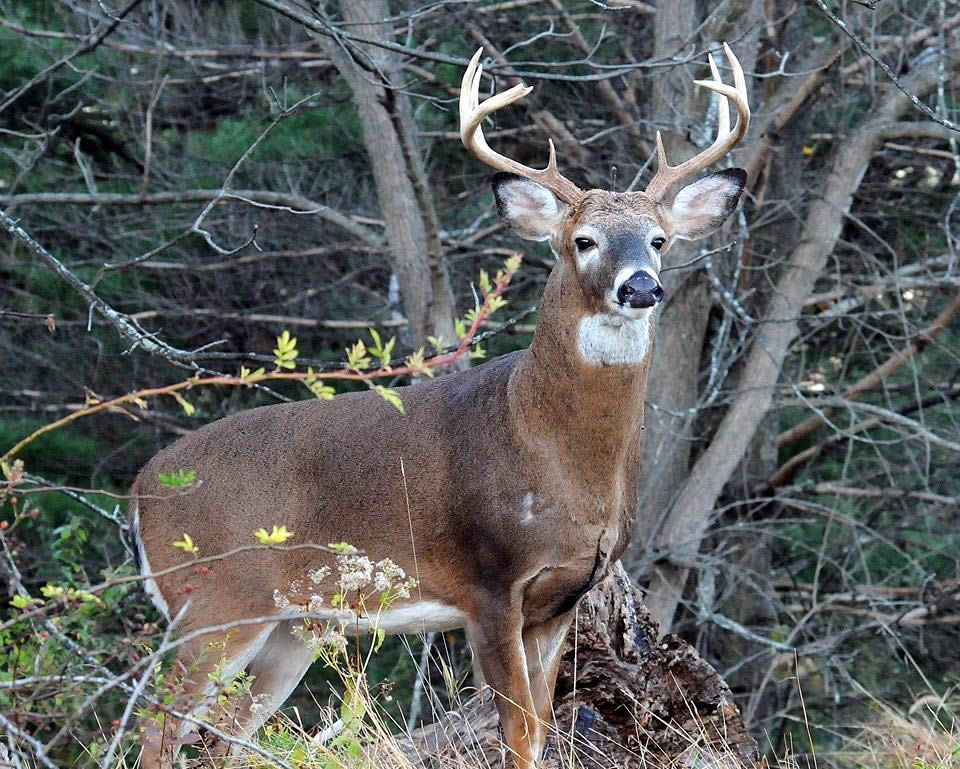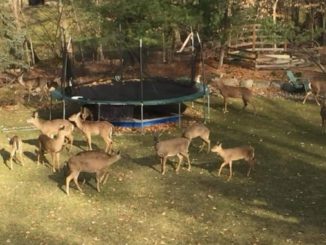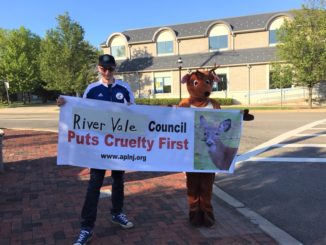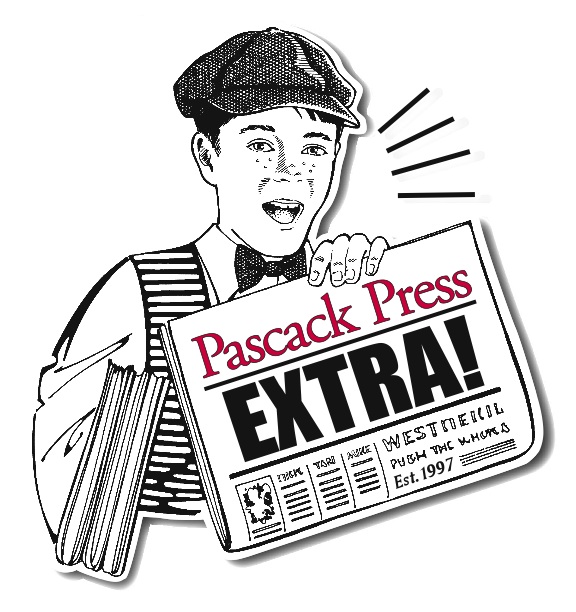
[slideshow_deploy id=’899′]
BY MICHAEL OLOHAN
OF PASCACK PRESS
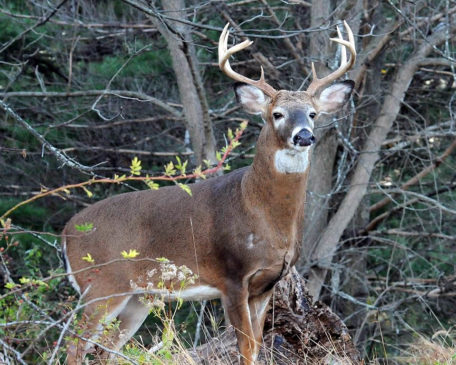
RIVER VALE—Following a meeting Oct. 9 on deer management options—including a possible local deer hunt—the River Vale Town Council agreed to hear from a statewide animal protection group and coordinate with the New Jersey Division of Fish and Wildlife.
Business Administrator Gennaro Rotella charcterized the meeting as civil, and said seven residents from River Vale, Park Ridge, Hillsdale, and Montvale spoke.
Rotella noted that the township’s ordinance prohibiting wildlife feeding won praise as an important step in managing the deer population.
Although deer management was not an agenda item, speakers cited an Oct. 8 article in Pascack Press that quoted Mayor Glen Jasionowski saying that a deer hunt was a likely plan.
Jasionowski told area mayors Oct. 3 at a Greater Pascack Valley Chamber of Commerce forum that “it’s not finalized yet, but that’s the direction we’re going.”
Jasionowski said he originally opposed a hunt, but after consulting with a variety of experts, he agreed “That’s the only way.”
Representatives from the Animal Protection League of New Jersey offered non-lethal options at the River Vale meeting—including deer sterilization—as options to a deer culling proposal. Rotella said speakers supported alternatives to a hunt and that the mayor and council are committed to “listening to both sides of the issue before anything is done.”
Rotella said representatives from 12 towns attended an informal information session with state fish, game and wildlife officials in March 2017 in River Vale to hear about deer management options.
In an email to Pascack Press, and posted on social media, Mark and Kim Nagelhout, whose email address begins “savenjdeer,” urged residents to attend the Oct. 9 meeting and request the council to hear a full presentation from the Animal Protection League of New Jersey on non-lethal deer control options.
“This [hunt proposal] should be very scary to residents. Our safety and property values would be jeopardized. Hunting will not resolve conflicts with deer,” states the email.
“Animal Protection League of N.J. is offering a free non-lethal deer conflict management presentation to River Vale. So far, they failed to take us up on this offer,” the email read.
At the meeting, Jasionowski downplayed safety concerns over a potential hunt, saying if a hunt were to be authorized, it would be in a controlled setting on a golf course involving bait and professional bow hunters.
“I was elected by the 10,000 residents that live in River Vale,” said Jasionowski. “And I have to do what the majority want me to do.”
Jasionowski cited an increase in deer-related incidents “in excess of 50 so far this year,” a couple local Lyme disease cases, and deforestation of a local nature sanctuary as rationale for a deer hunt to manage an increasing population.
Mark Nagelhout downplayed concerns that the deer are spreading Lyme disease, saying deer ticks are hosted by all mammals and song birds and suggested there are alternative and more effective ways of preventing tick bites than lethal deer hunts.
Incidents more frequent
River Vale Police Chief William Giordano said Oct. 11 that deer-related problems are increasing yearly.
“This is the time of the year when issues with the deer increase in frequency,” he said, noting the yearly fall/winter deer-mating season.
Giordano asked drivers to be more aware of deer on local roads and said deer have been responsible for at least two deer/police vehicle collisions yearly.
The latest police vehicle collision occurred a week ago, said Giordano. Council President Mark Bromberg said at the meeting that every police car in the township has been damaged in an incident with a deer, saying “We’ve lost several police cars, too.”
“There is a problem,” said Bromberg. “We will have to do something, but we’re listening to everybody at this point.”
Giordano said since the township’s wildlife feeding ordinance was passed in March, the chief said they’ve had no complaints.
“The deer are a problem. Never in my life have I seen such a large population of deer,” he said.
He attributed the increase to development, loss of habitat, and increased deer reproduction. He reported seeing does with two or more fawns, not just one.
Saddle River hunt ‘stayed’
In nearby Saddle River, which proposed a deer culling plan involving professional bowhunters, a Superior Court judge halted the operation on Oct. 5 pending her review of whether the township maintained the proper paperwork required to conduct the state-approved bowhunt.
The paperwork—requested in a public records request by Animal Protection League of New Jersey attorney Doris Lin—included a roster of 20 bowhunters required to be on file 30 days prior to the hunt and copies of waivers from 20 hunters so police can conduct background checks.
A ruling on the Animal Protection League’s motions to have Saddle River’s deer hunting ordinance and contract with United Bowhunters of America nullified was expected after press time.
Deer sterilization denial
Appearing before a Bergen County’s League of Municipalities meeting Oct. 9—including approximately 20 mayors—Lin said state Fish, Game & Wildlife rejected Saddle River’s initial proposal for a surgical sterilization program for two reasons.
She said the state disapproval was because it “cannot be both a population reduction and an experiment to determine population impacts” and “fertility research projects conducted in other states are numerous in results with low expectations of successfully reducing deer in an open population or reducing human-deer conflicts in a timely or cost-efficient manner.”
“It’s because of their bias against fertility treatments,” Lin told the mayors. “Non-lethal strategies are a win-win for the town, for the deer and for the people,“ she said.
Noting that deer management “has been a nightmare” for Saddle River, Alpine Mayor Paul Tomasko asked how a town can keep deer from “proliferating to the point where they become so unwelcome, if not also controversial?”
Lin said she did not think other towns “would do much better without a change in (state) policy” to consider a sterilization program.
“Thank you for the forthrightness,” Tomasko replied.
Demarest Mayor Ray Cywinski, also a watershed manager for Suez Water, said the forest understory in large areas of watershed property has disappeared due to deer browsing and deforestation. He said only invasive species appear to germinate.
“The trees don’t even have a chance to germinate. They germinate and they’re browsed [by deer],” said Cywinski.
‘Grazing like cows’
“They’re grazing like cows on golf courses,” added Cywinski. “I can count 30 in a half-mile stretch when I go home from work,” he added. noting “a definite environmental impact” from increased deer population.
Lin provided a Powerpoint presentation and advocated for both deer sterilization and contraception as alternatives to deer hunting.
She said the Animal Protection League recommended sterilization via ovariectomies, which involves removing does’ ovaries during an approximately 20-minute surgery.
The cost is about $1,000 to $1,200 per doe, she said. She noted that, had the Saddle River program received state approval, it would have been funded entirely by private donations.
She said immunocontraception involved injecting pig enzymes into female deer, including two initial doses of contraception and annual boosters, can be effective.
She said that state Fish, Game & Wildlife only recognizes two categories of non-lethal deer control: chemical fertility control and track and transfer.
“There’s no mention of surgical sterilization,” Lin said, urging mayors to request sterilization be added to the state’s approved list of non-lethal options.
Lin said any non-lethal deer management program must receive a permit from state Fish, Game and Wildlife officials and that the application must explain why traditional deer control methods—hunting—did not work.
Lin said the state agency “has strong incentives” to increase the number of hunters, including selling seasonal licenses.

